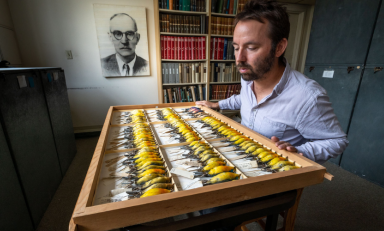The speech Los Angeles Unified School DistrictSuperintendent John Deasy gave before a packed auditorium at Occidental College on September 14 wasn't just an outline of education goals. It was a call to action: Overhaul the deeply challenged 678,000-student urban district so it can once again be a national leader in K-12 education.
Basing teacher pay on performance and implementing a more meaningful teacher evaluation system are just two key factors to help improve student learning, Deasy said in his policy address, "Education Reform: The Full Contact Sport of Transforming Schools." The district is in the midst of negotiating a new labor contract with United Teachers of Los Angeles, and the schools chief spent much of his time focusing on L.A. Unified's 29,734 early-childhood and K-12 teachers.
"No one has told me the current evaluation system helps anyone," he said. "It is fundamentally useless."
"Teaching is remarkably complex, highly nuanced, and highly technical work," he added. "Not everyone can do it, and not everyone should."
Deasy also espouses a three- to five-year probationary period before teachers are granted tenure in place of the current two-year period. In addition, he aims to reward high-performing teachers with extra compensation-a controversial subject among teacher unions nationwide. Traditionally, teacher pay and raises are based not on student performance but on factors including certification, seniority, and professional development.
"We have a very structured system," Deasy said. "You're given a raise [based] on how long you've taught ... but not on how well you do your job. That is not OK."
Encouraging high-performing charter schools, closing low-performing ones, and giving principals the power to hire their own teachers are a few other ways Deasy is changing how the district works. These actions will work in tandem to reach a series of ambitious goals he announced in April, when he took over L.A. Unified's top spot.
They include raising the graduation rate from 55 percent to 70 percent in four years; doubling the percentage of middle and high school students who test "proficient" in math; and tripling the percentage of students who pass courses required to attend state four-year universities. Other district goals include improving English comprehension, attendance, and suspension rates.
"Every single youth in this city has the right to graduate from college," he said. "Not most, and not some ... it is every single student. We have to have an unshakeable belief that every student can and will graduate from high school and be workforce ready."
The stakes are also high, the superintendent said, because Los Angeles is a bellwether for the rest of the country. How the district deals with academic, fiscal, and other challenges can help guide other school systems nationwide. "Los Angeles is America, only sooner," Deasy said. "L.A. is coming to a town near you pretty quickly."
In addition, the schools chief is launching the Los Angeles Fund for Public Education. This philanthropic organization seeks to raise $200 million for the district over five years to help fund student health, the arts, teacher support, and system transformation. Like other school districts in California, L.A. Unified has had its budget slashed in recent years. It faces a $400-million shortfall in its $6-billion operating budget this year.
Deasy acknowledged that while L.A. Unified has good students and schools, it has a very long way to go: Only 56 percent of the district's students graduate in four years compared to the national average of 72 percent; less than a quarter of L.A. Unified graduates are ready to enter a competitive college or university; and about 23 percent of the district's students drop out completely.
"But that is a photograph--not a movie--of where we are in L.A. We are at a critical crossroads," Deasy said. "We can chart a very bold course of transformation to gain our place at the forefront of education."
| John Deasy Speech: |
| John Deasy Q & A: |



